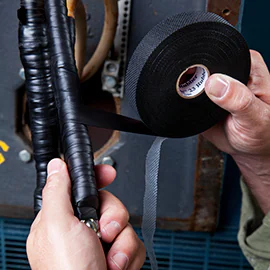Understanding Yellow Tape and its Role in Electrical Work
In the world of electrical installations and repairs, safety and efficiency are of utmost importance. One tool that plays a crucial role in ensuring both is the yellow electrical tape. Often overlooked in discussions about electrical materials, yellow tape is integral for various applications, from marking important zones to providing insulation and aiding in color coding. This article delves into the multifaceted uses of yellow tape in electrical work while emphasizing safety protocols essential in the industry.
What is Yellow Electrical Tape?
Yellow electrical tape, like other types of electrical tape, is typically made from a stretchy vinyl material that can withstand high temperatures. It is color-coded for specific purposes, with yellow often used to signal caution or to indicate the phase of electrical wiring. This vibrant color ensures that anyone handling electrical components can quickly identify potential hazards or critical areas.
Safety Markings and Warnings
One of the most vital applications of yellow electrical tape is in marking and labeling. For technicians working on high-voltage installations or in areas where electrical hazards are prevalent, yellow tape can serve as a warning sign. It is often used to delineate restricted zones or to mark certain electrical equipment as live. This precaution is essential for minimizing risks and preventing accidents, particularly in environments where multiple tradespeople may be working simultaneously.
Color Coding for Efficiency
In electrical work, color coding is crucial for organization and efficiency. Yellow electrical tape can be used to color-code different wires in a complex installation. For instance, it may identify certain circuits, signals, or connections. This not only streamlines the work process but also eases future troubleshooting efforts. When electrical systems require maintenance, technicians can quickly discern which wires correspond to which functions, reducing the likelihood of errors.
yellow tape electrical

Insulation Properties
Another significant characteristic of yellow electrical tape is its insulation properties. Although not as prevalent as black electrical tape, which is the standard for insulating electrical connections, yellow tape can provide additional insulation for specific uses. It is useful for wrapping exposed wires or connections, thereby reducing the risk of short-circuits and electrical shocks. However, electricians should ensure that the tape used is rated for the specific voltage levels to maintain optimal safety standards.
Temporary Repairs and Bonding
Yellow electrical tape can also be employed for temporary repairs in various settings. In situations where there is immediate need for electrical connections to be secured, wrapping the exposed wire can protect it from accidental contact or environmental factors. While it is essential to follow up with proper long-term solutions, yellow tape serves as a quick fix to maintain functionality until a permanent repair can be made.
Conclusion The Value of Yellow Tape in Electrical Work
The importance of yellow electrical tape goes beyond its mere presence in an electrician's toolkit. It encapsulates principles of safety, organization, and efficiency in an industry where missteps can lead to serious consequences. Whether it is marking hazards, providing essential color coding, or offering temporary solutions, yellow tape is a pivotal ally for professionals.
Electricians must be aware of the correct applications and limitations of yellow tape, ensuring that it is used appropriately alongside other tools and materials. As with any tool in the electrical trade, adhering to safety standards and utilizing the right products can make all the difference not only in achieving effective installations but also in safeguarding lives. In conclusion, while it may seem simple, yellow electrical tape is a potent asset in maintaining the integrity and safety of electrical work.
-
XIANGFAN Rubber Tape-Ultimate Solutions for All Your Insulation NeedsNewsJun.24,2025
-
XIANGFAN Rubber Tape-Protection for Industrial and Residential ApplicationsNewsJun.24,2025
-
XIANGFAN Rubber Tape: Superior Safety and Sealing for Demanding EnvironmentsNewsJun.24,2025
-
XIANGFAN Rubber Tape: Reliable Solutions for Every Electrical ChallengeNewsJun.24,2025
-
XIANGFAN Electrical & Industrial Tape: Powering Reliability Across IndustriesNewsJun.24,2025
-
XIANGFAN Electrical & Industrial Tape: Excellence in Every ApplicationNewsJun.24,2025
